The chicest interior door colors you’ll want in your home in 2025
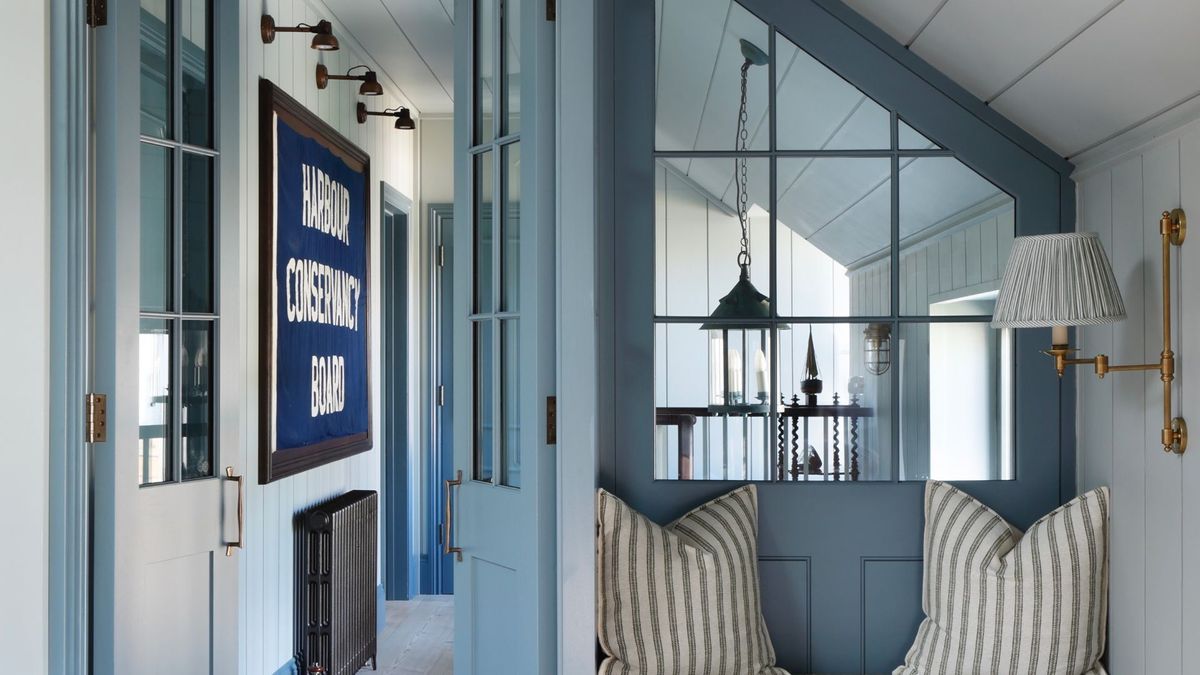
If you want to experiment with bright, daring colors but tend to shy away from them in case they are too domineering, or dream of trying out the latest emerging color trends but worry they’ll be out of style in the blink of an eye, interior doors offer the perfect opportunity to experiment.
Painting interior doors is relatively low-risk compared to painting a whole room or wall. If needed, an internal door can be repainted swiftly and without much hassle, so it’s the perfect spot to experiment with paint ideas.
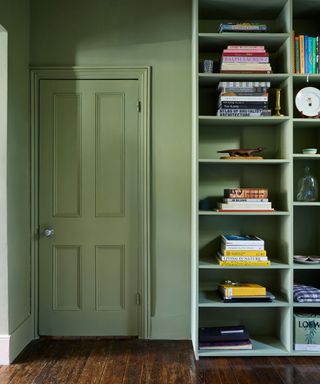
(Image credit: Farrow & Ball)
There is no need to feel beholden to white or magnolia woodwork. Patrick O’Donnell, Brand Ambassador at Farrow & Ball, suggests opting for something altogether much bolder.
‘Flip the usual convention of white woodwork on its head and choose a darker color for your doors and skirting,’ he suggests. ‘This feels overtly modern whilst not being a slave to trends. It adds a subtle detail of interest to a room and works in both urban and rural settings.’
That’s not to say you should necessarily steer clear of neutrals altogether. Jaime Zehner, the founder and principal designer of California-based JZ Interiors, explains how to do this so it doesn’t look boring or uninspiring.
‘We often opt for a slight contrast on our doors and baseboards, even if it’s only a shade off and in a different sheen for protection. Soft neutrals like Farrow & Ball’s Skimming Stone or Strong White keep things timeless and refined, while deeper hues such as Down Pipe or Hague Blue bring drama and definition. For a more relaxed, sun-warmed feel, muted greens like French Gray or rich taupes like Hardwick White offer a natural, effortless elegance. The key is to think of doors as architectural elements – choosing a color that enhances your interior palette rather than fading into the background.’
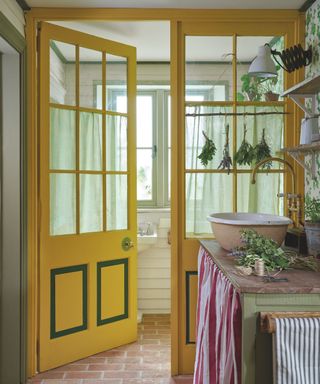
Happily, re-painting an internal door is very straightforward and can be the perfect quick and easy DIY project. If you’re planning on a dramatic color swap, it’s worth remembering to prime the woodwork as Ruth Mottershead, Creative Director at Little Greene suggests.
She explains ‘If you are making a radical color change such as black to white, it may be worth first priming the surface. Before priming your woodwork, you should first sand the surface, and we would recommend applying wood filler to any gaps or imperfections. When painting apply brush strokes in the same direction as the wood’s natural grain for the best finish.’
Here, we’ve gathered 7 of the best colors for interior doors for you to take inspiration from, so you can unlock the potential of the doors around your home.
1. Muted blues
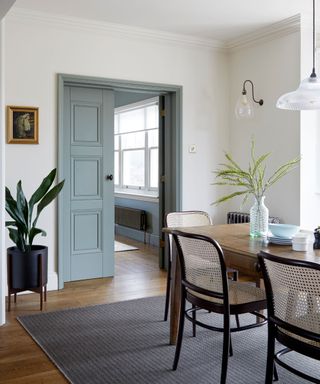
Carolina Gull by Benjamin Moore
(Image credit: Anna Stathaki )
You may think that blue is a tricky colour to get right, especially if you’ve had a bad experience with some of the more gray-leaning blues with a certain flat coldness. The key to decorating with blue lies in getting the specific tone just right. Opting for versatile green-blue paint is excellent for adding visual interest with a pop of colour to internal doors, without it becoming domineering.
Carolina Gull by Benjamin Moore has notes of gray, cool blue, and warm green. The soft green notes add warmth, while the pale blue notes bring a certain freshness. As such, the atmosphere this colour brings to a room can be altered depending on its companion colours. Set amongst khaki greens, muddy browns and warm neutral tones, it will appear much moodier. Paired with crisp whites and high levels of natural light, it will transform into the fresh, cool, softly muted blue you see here.
Fiona Duke, the UK-based interior designer who selected this paint color for the internal doors in this project, explains ‘Introducing Carolina Gull by Benjamin Moore on the bespoke double doors injects a wonderful colour burst and creates an element of fun into this open plan space. It helps to zone the space and is a simple way of providing a focal feature within a relatively neutral concept without feeling too overpowering.’
2. Vivid greens
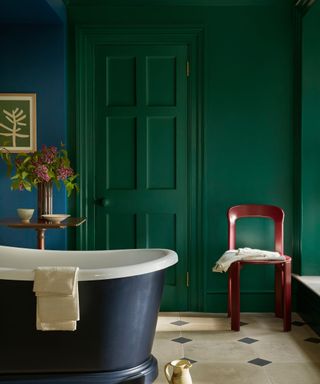
Mid Azure Green by Little Greene
(Image credit: Little Greene)
If you’re hunting for color-drenching ideas to achieve a bold and cohesive look, then adventurous, unbashful deep greens can deliver the most almighty visual impact. Color drenching is a paint trend we’re unlikely to see fizzle out, and if it is something you’re thinking of putting your hand to, don’t forget to also smother the room’s door and framing in the same colour, for maximum impact.
Little Greene’s Mid-Azure Green is a rich, opulent and deeply luxurious colour that packs a paradisical punch. Ruth Mottershead, Creative Director at Little Greene describes Mid Azure Green as ‘a splendid, sophisticated green-blue teal colour.’ Ruth explains ‘The depth of this shade adds an air of sophistication to an interior, with its vibrant finish being an excellent highlight for interior doors and woodwork. It works brilliantly when combined with vibrant ‘Deep Space Blue’ and indulgent indigo-hued ‘Dock Blue’ in a drenched interior that will elicit both contrast and harmony, their cohesion formed by their shared pigments and their contrast by their varying undertones. This balanced colour palette, which feels both energetic and calming.’
3. Rich browns
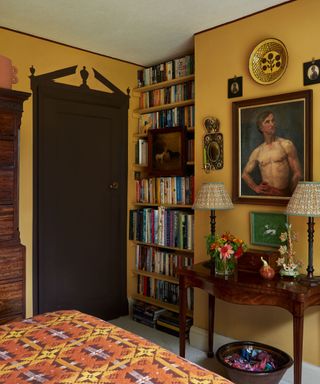
(Image credit: Farrow & Ball)
Painting an internal door in a fabulously rich brown adds depth and character that lighter shades struggle to match.
There are hundreds of brown paint colours in a wide spectrum of shades, but for something with warming terracotta-red undertones, try Affogato by Little Greene. For a more neutral-toned brown try Elderton by Graham & Brown. If sumptuous deep, tobacco brown is what you’re after, Cola by Farrow & Ball is enduringly tasteful and well-judged for delivering maximum drama with perennial appeal.
Patrick O’Donnell agrees that brown can make for a really sophisticated internal door color, explaining, ‘Dark chocolates, such as our archived Cola, can look so chic. They pair well with mid-blues, dirty whites, or warm caramels, such as our archive shade Cane, which will positively glow.’
4. Bright yellows
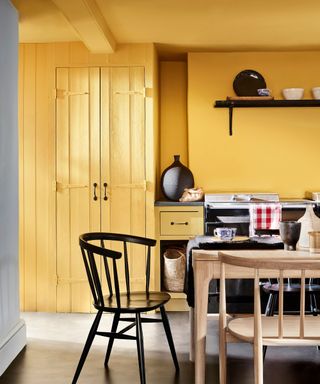
(Image credit: Little Greene)
Incorporating yellow paints into your home can feel intimidating. If you love the smile-inducing qualities of yellow, but painting your walls floor to ceiling in a blaze of dazzling yellow seems too much, consider using this sunny colour on doors instead.
Decorating with yellow is an undoubtedly mood-booster; they have innate wakeful and joy-sparking qualities, which is ideal for busy rooms like kitchens, utility rooms, garden rooms, playrooms, and entryways.
Bright, bombastic yellows like Giallo by Little Greene work particularly well in contemporary interiors. Yellow paints on the more subtle, mellow, golden end of the spectrum, like Hay by Farrow & Ball, always look fantastically sharp in traditional interiors. ‘Giallo is an uncompromising, yet very easy-to-use, burst of golden sunshine,’ explains Ruth Mottershead. ‘A charming highlight or accent color, it’s most splendid when used in a large expanse as colour-drenched interior across walls and woodwork.’
5. Dramatic reds
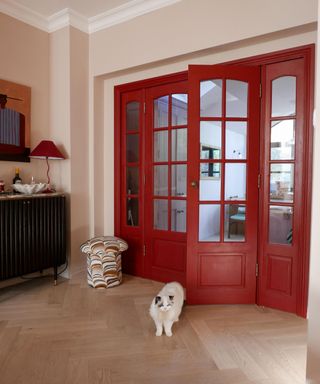
Red HTK 57 by Lick x Heinz
(Image credit: lucyalicehome)
There may not be a better way to implement the unexpected red theory in your home than painting an internal door in a shock of red. The spectrum of red colors is vast, from subdued clay-coloured reds to brilliant post-box red and moody deep, dark clarets.
For example, a deep crimson can have a dramatic and evocative incarnadine effect. A bright, brilliant vermilion-red is a more upbeat and playful. If it’s a softer terracotta red you’re after, bear in mind that the merest amount of red pigment will be on the paler side, which will deliver a soft and calming warmth as opposed to full-throttle heat.
Darker, more dramatic red earths, orangey terracottas, and pink-imbued clays create a cosy, warming ambiance and an easygoing, handcrafted, artisanal feel. That said, the aesthetic reach of these tones is considerable, and as such, they can work beautifully in more formal settings too, especially when used with crisp whites.
@lucyalicehome, who shares updates on the renovations to her London cottage on Instagram, painted her internal doors in Lick x Heinz Tomato Ketchup Red, a great example of introducing a pop of color that has totally elevated and transformed a space.
6. Soft gray
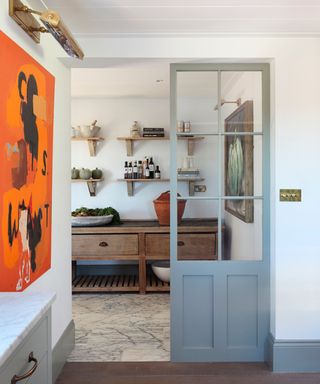
Gray paint, once the ubiquitous staple, hailed as the ultimate chic neutral that could be relied upon entirely, became at some undefinable point, somewhat oversubscribed and so swiftly fell out of fashion.
That said, so many grays are still enduringly timeless and smart, especially when delivered in small, purposeful doses. If gray is the main colour story in a room, it can appear cold, corporate and gloomy. However, if used on trims, doors, baseboards, and woodwork like closets and stairs, it is a wonderful failsafe neutral that can look remarkably tasteful and a great alternative to off-white.
Pigeon by Farrow & Ball is softer and bluer than more contemporary gray shades, great at creating a calming space that feels genuinely timeless.
7. Luxurious purple
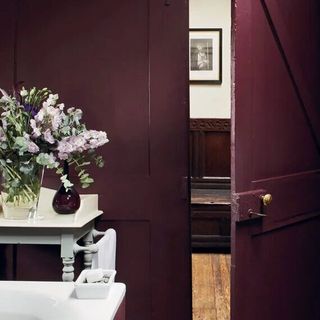
(Image credit: Farrow & Ball)
Decorating with purple can feel a bit risky. It may feel too bold or too extravagant, and that it does not possess the elegance and timelessness to be an enduringly tasteful option. But we say there’s no need to shy away from experimenting with this marvellously striking colour. Thanks to its regal connotations, dark purple creates an air of opulence that no other colour can compete with.
Dark purple paint can create spaces that are moody, refined, and inviting, and when used in full gloss on woodwork such as internal doors, staircases, library shelves and windows, they are particularly showstopping.
Brinjal by Farrow and Ball, which takes its name from the rich and glossy skin of an eggplant, is a spectacular example of a rich, moody deep purple. If you love the abundance and abandon of maximalism, adding a riot of saturated deep purple will have the desired effect.
Painting your internal doors in a color you truly love is a wonderful way to bring more excitement to your home. You may wish to do that by adding different bright shades throughout your home to bring the drama, or use the same color on all internal doors to maintain one color scheme. Either way, you’ll be sure to add layers of visual interest with your internal doors that will thrill as much as they function.
link



:max_bytes(150000):strip_icc()/faw-outdoorpatio-furniture-deals-tout-serp-1542929de40a47ec93a90e50706c0611.jpg)
